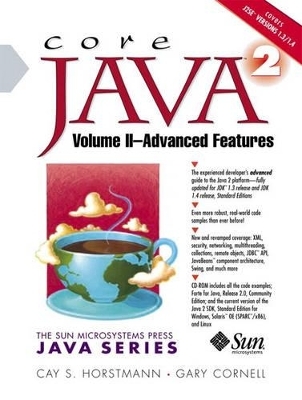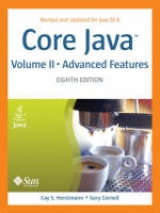
Core Java™ 2, Volume II--Advanced Features
Prentice Hall
978-0-13-092738-5 (ISBN)
- Titel erscheint in neuer Auflage
- Artikel merken
For intermediate-to-advanced-level undergraduate courses in Java programming.
Designed specifically for students with development experience, the best selling Core Java offers real-world guidance for using Java to solve even the most challenging programming problems. This Fifth Edition has been thoroughly updated for Sun's JDK 2 Version 1.3 and 1.4, and adds significant coverage in many of today's most important areas of Java programming -- notably XML, servlets, security, and native methods.
CAY S. HORSTMANN is Professor of Computer Science at San Jose State University. He has written six books on C++, Java technology, and object-oriented development, is series editor for Core books at Prentice Hall, and is a frequent speaker at computer industry conferences. A columnist for Java Report, he spent four years as Vice President and Chief Technology Officer of an Internet startup that grew from three people to a public company. GARY CORNELL has written or co-written over 20 popular computer books. He has a Ph.D. from Brown University and has been a visiting scientist at IBM Watson Labs, as well as a professor at the University of Connecticut.
Preface.
To the Reader.
About This Book.
Conventions.
Definitions.
Acknowledgments.
1. Multithreading.
What Are Threads? Using Threads to Give Other Tasks a Chance. Running and Starting Threads. Running Multiple Threads. The Runnable Interface. Interrupting Threads. Thread Properties. Thread States. Moving Out of a Blocked State. Dead Threads. Daemon Threads. Thread Groups. Thread Priorities. Selfish Threads. Synchronization. Thread Communication Without Synchronization. Synchronizing Access to Shared Resources. Object Lock. The wait and notify Methods. Synchronized Blocks. Synchronized Static Methods. Deadlocks. Why the stop and suspend Methods Are Deprecated. Timeouts. User Interface Programming with Threads. Threads and Swing. Animation. Timers. Progress Bars. Progress Monitors. Monitoring the Progress of Input Streams. Using Pipes for Communication Between Threads.
2. Collections.
Collection Interfaces. Separating Collection Interfaces and Implementation. Collection and Iterator Interfaces in the Java Library. Concrete Collections. Linked Lists. Array Lists. Hash Sets. Tree Sets. Maps. Specialized Map Classes. The Collections Framework. Views and Wrappers. Bulk Operations. Interfacing with Legacy APIs. Algorithms. Sorting and Shuffling. Binary Search. Simple Algorithms. Writing Your Own Algorithms. Legacy Collections. The Hashtable Class. Enumerations. Property Sets. Stacks. Bit Sets.
3. Networking.
Connecting to a Server. Implementing Servers. Serving Multiple Clients. Sending E-Mail. Advanced Socket Programming. URL Connections. URLs and URIs. Using a URLConnection to Retrieve Information. Posting Form Data. CGI Scripts and Servlets. Sending Data to a Web Server. Harvesting Information from the Web. Applet Security. Proxy Servers. Testing the WeatherReport Applet.
4. Database Connectivity: JDBC.
The Design of JDBC. Typical Uses of JDBC. The Structured Query Language. Installing JDBC. Basic JDBC Programming Concepts. Database URLs. Making the Connection. Executing SQL Commands. Advanced SQL Types (JDBC 2). Populating a Database. Executing Queries. Scrollable and Updatable Result Sets. Scrollable Result Sets (JDBC 2). Updatable Result Sets (JDBC 2). Metadata. Transactions. Batch Updates (JDBC 2). Advanced Connection Management.
5. Remote Objects.
Introduction to Remote Objects: The Roles of Client and Server. Remote Method Invocations. Stubs and Parameter Marshalling. Dynamic Class Loading. Setting Up Remote Method Invocation. Interfaces and Implementations. Locating Server Objects. The Client Side. Preparing for Deployment. Deploying the Program. Parameter Passing in Remote Methods. Passing Nonremote Objects. Passing Remote Objects. Using Remote Objects in Sets. Cloning Remote Objects. Inappropriate Remote Parameters. Using RMI with Applets. Server Object Activation. Java IDL and CORBA. The Interface Definition Language. A CORBA Example. Implementing CORBA Servers.
6. Advanced Swing.
Lists. The JList Component. List Models. Inserting and Removing Values. Rendering Values. Trees. Simple Trees. Node Enumeration. Rendering Nodes. Listening to Tree Events. Custom Tree Models. Tables. A Simple Table. Table Models. A Sort Filter. Cell Rendering and Editing. Working with Rows and Columns. Selecting Rows, Columns, and Cells. Styled Text Components. Component Organizers. Split Panes. Tabbed Panes. Desktop Panes and Internal Frames. Cascading and Tiling. Vetoing Property Settings.
7. Advanced AWT.
The Rendering Pipeline. Shapes. Using the Shape Classes. Areas. Strokes. Paint. Coordinate Transformations. Clipping. Transparency and Composition. Rendering Hints. Reading and Writing Images. Obtaining Readers and Writers for Image File Types. Reading and Writing Files with Multiple Images. Image Manipulation. Accessing Image Data. Filtering Images. Printing. Printing Graphics. Printing Multiple Pages. Print Preview. Print Services. Stream Print Services. Printing Attributes. The Clipboard. Classes and Interfaces for Data Transfer. Transferring Text. The Transferable Interface and Data Flavors. Building an Image Transferable. Using a Local Clipboard to Transfer Object References. Transferring Java Objects via the System Clipboard. Drag and Drop. Drop Targets. Drag Sources. Data Transfer Support in Swing.
8. JavaBeans”.
Why Beans? The Bean-Writing Process. Using Beans to Build an Application. Packaging Beans in JAR files. Composing Beans in a Builder Environment. Naming Patterns for Bean Properties and Events. Bean Property Types. Simple Properties. Indexed Properties. Bound Properties. Constrained Properties. Adding Custom Bean Events. Property Editors. Writing a Property Editor. Going Beyond Naming Patterns. FeatureDescriptor Objects. Customizers. Writing a Customizer Class. The Bean Context. Advanced Uses of Introspection. Finding Sibling Beans. Using Bean Context Services.
9. Security.
Class Loaders. Writing Your Own Class Loader. Bytecode Verification. Security Managers and Permissions. Java 2 Platform Security. Security Policy Files. Custom Permissions. Implementing a Permission Class. A Custom Security Manager. User Authentication. Digital Signatures. Message Digests. Message Signing. Message Authentication. The X.509 Certificate Format. Generating Certificates. Signing Certificates. Code Signing. Signing JAR Files. Deployment Tips. Software Developer Certificates. Encryption. Symmetric Ciphers. Public Key Ciphers. Cipher Streams.
10. Internationalization.
Locales. Numbers and Currencies. Date and Time. Text. Collation (Ordering). Text Boundaries. Message Formatting. Choice Formats. Character Set Conversion. International Issues and Source Files. Resource Bundles. Locating Resources. Placing Resources into Bundles. Graphical User Interface Localization. Localizing an Applet.
11. Native Methods.
Calling a C Function from the Java Programming Language. Working with the printf Function. Numeric Parameters and Return Values. Using printf for Formatting Numbers. String Parameters. Calling sprintf in a Native Method. Accessing Object Fields. Accessing Static Fields. Signatures. Calling Java Methods. Nonstatic Methods. Static Methods. Constructors. Alternative Method Invocations. Arrays. Error Handling. The Invocation API. A Complete Example: Accessing the Windows Registry. An Overview of the Windows Registry. A Java Platform Interface for Accessing the Registry. Implementing the Registry Access Functions as Native Methods.
12. XML.
An Introduction to XML. The Structure of an XML Document. Parsing an XML Document. Document Type Definitions. A Practical Example. Namespaces. Using the SAX Parser. Generating XML Documents. XSL Transformations.
Index.
| Erscheint lt. Verlag | 19.12.2001 |
|---|---|
| Verlagsort | Upper Saddle River |
| Sprache | englisch |
| Maße | 178 x 235 mm |
| Gewicht | 1714 g |
| Themenwelt | Informatik ► Programmiersprachen / -werkzeuge ► Java |
| Mathematik / Informatik ► Informatik ► Web / Internet | |
| ISBN-10 | 0-13-092738-4 / 0130927384 |
| ISBN-13 | 978-0-13-092738-5 / 9780130927385 |
| Zustand | Neuware |
| Informationen gemäß Produktsicherheitsverordnung (GPSR) | |
| Haben Sie eine Frage zum Produkt? |
aus dem Bereich


